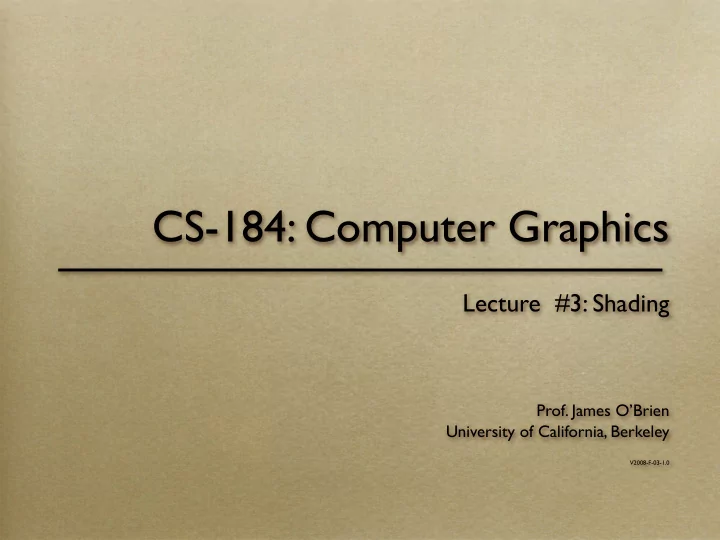

CS-184: Computer Graphics Lecture #3: Shading Prof. James O’Brien University of California, Berkeley V2008-F-03-1.0
Today Local Illumination & Shading The BRDF Simple diffuse and specular approximations Shading interpolation: flat, Gouraud, Phong Some miscellaneous tricks 2
Local Shading Local: consider in isolation 1 light 1 surface The viewer Recall: lighting is linear Almost always... 3 Counter example: photochromatic materials
Local Shading Examples of non-local phenomena Shadows Reflections Refraction Indirect lighting 4
The BRDF The B i-directional R eflectance D istribution F unction Given ρ ( θ V , θ L ) ρ = Surface material ρ ( v , l , n ) = Incoming light direction Direction of viewer Orientation of surface Return: fraction of light that reaches the viewer We’ll worry about physical units later... 5
The BRDF ρ ( v , l , n ) ˆ n ˆ l ˆ v Spatial variation capture by “the material” Frequency dependent Typically use separate RGB functions Does not work perfectly Better: ρ = ρ ( θ V , θ L , λ in , λ out ) 6
Obtaining BRDFs Measure from real materials Images from Marc Levoy 7
Obtaining BRDFs Measure from real materials Computer simulation Simple model + complex geometry Derive model by analysis Make something up 8
Beyond BRDFs The BRDF model does not capture everything e.g. Subsurface scattering (BSSRDF) Images from Jensen et. al, SIGGRAPH 2001 9
Beyond BRDFs The BRDF model does not capture everything e.g. Inter-frequency interactions ρ = ρ ( θ V , θ L , λ in , λ out ) This version would work.... 10
A Simple Model Approximate BRDF as sum of A diffuse component A specular component A “ambient” term + + = 11
Diffuse Component Lambert’s Law Intensity of reflected light proportional to cosine of angle between surface and incoming light direction Applies to “diffuse,” “Lambertian,” or “matte” surfaces Independent of viewing angle Use as a component of non-Lambertian surfaces 12
Diffuse Component Comment about two-side lighting in text is wrong... k d I ( ˆ l · ˆ n ) max ( k d I ( ˆ l · ˆ n ) , 0 ) 13
Diffuse Component Plot light leaving in a given direction: Plot light leaving from each point on surface 14
Specular Component Specular component is a mirror-like reflection Phong Illumination Model A reasonable approximation for some surfaces Fairly cheap to compute Depends on view direction 15
Specular Component N v ) p k s I ( ˆ r · ˆ L V v , 0 ) p R k s I max ( ˆ r · ˆ 16
Specular Component Computing the reflected direction r = − ˆ l + 2 ( ˆ ˆ l · ˆ n ) ˆ n n r l θ n cos θ n cos θ ˆ - l l + ˆ v ˆ h = || ˆ l + ˆ v || n h l ω e 17
Specular Component Plot light leaving in a given direction: Plot light leaving from each point on surface 18
Specular Component Specular exponent sometimes called “roughness” n=1 n=2 n=4 n=8 n=16 n=32 n=64 n=128 n=256 19
Ambient Term Really, its a cheap hack Accounts for “ambient, omnidirectional light” Without it everything looks like it’s in space 20
Summing the Parts R = k a I + k d I max ( ˆ v , 0 ) p l · ˆ n , 0 )+ k s I max ( ˆ r · ˆ + + = Recall that the are by wavelength k ? RGB in practice Sum over all lights 21
Anisotropy 22
Metal -vs- Plastic 23
Metal -vs- Plastic 24
Other Color Effects 25
Other Color Effects darken pure blue to yellow + select = pure black to object color final tone Images from Gooch et. al, 1998 26
Measured BRDFs BRDFs for automotive paint 27 Images from Cornell University Program of Computer Graphics
Measured BRDFs BRDFs for aerosol spray paint 28 Images from Cornell University Program of Computer Graphics
Measured BRDFs BRDFs for house paint 29 Images from Cornell University Program of Computer Graphics
Measured BRDFs BRDFs for lucite sheet 30 Images from Cornell University Program of Computer Graphics
Details Beget Realism The “computer generated” look is often due to a lack of fine/subtle details... a lack of richness. 31 From bustledress.com
Direction -vs- Point Lights For a point light, the light direction changes over the surface For “distant” light, the direction is constant Similar for orthographic/perspective viewer 32
Falloff 1 / r 2 Physically correct: light intensify falloff Tends to look bad (why?) Not used in practice Sometimes compromise of used 1 / r 33
Spot and Other Lights Other calculations for useful effects Spot light Only light certain objects Negative lights etc. 34
Surface Normals The normal vector at a point on a surface is perpendicular to all surface tangent vectors For triangles normal given by right-handed cross product 35
Flat Shading Use constant normal for each triangle (polygon) Polygon objects don’t look smooth Faceted appearance very noticeable, especially at specular highlights Recall mach bands... 36
Smooth Shading Compute “average” normal at vertices Interpolate across polygons Use threshold for “sharp” edges Vertex may have different normals for each face 37
Gouraud Shading Compute shading at each vertex Interpolate colors from vertices Pros: fast and easy, looks smooth Cons: terrible for specular reflections Flat Gouraud 38 Note: Gouraud was hardware rendered...
Phong Shading Compute shading at each pixel Interpolate normals from vertices Pros: looks smooth, better speculars Cons: expensive Gouraud Phong 39 Note: Gouraud was hardware rendered...
Recommend
More recommend